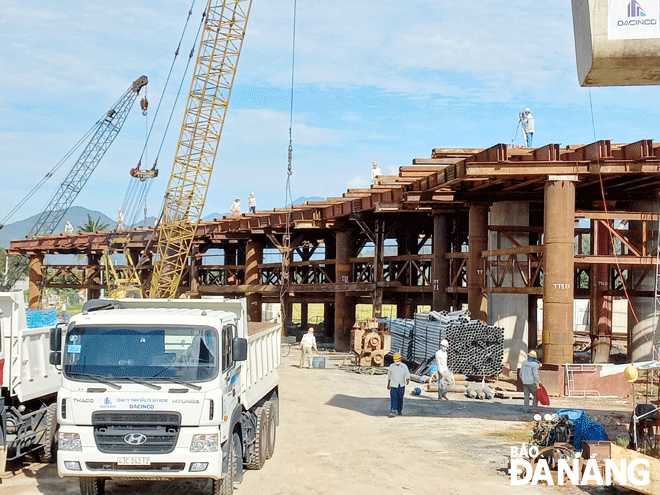Da Nang seeks ways to help construction businesses address difficulties
Many construction enterprises are facing a series of unprecedented difficulties and challenges, including a shortage of skilled construction workers, a surge in prices of building materials, and cumbersome administrative procedures.
 |
| The crucial Western Ring Road No.2 project, one of Da Nang's key projects, is underway. |
Many construction enterprises left market
According to the Business Registration Office under the Da Nang Department of Planning and Investment, as of August 2022, 797 city-based enterprises faced a high risk of having their business registration certificates revoked.
The reasons are that these enterprises have not operated at the registered addresses for one year or more, have not sent their operation report, and have been coerced to owe tax by revoking the enterprise registration certificates according to regulations.
Previously, the revocation of business registration certificates was often concentrated in the groups of trade and service industries, but now it has shifted to the construction industry with the focus on construction and installation, design consultancy, and construction materials fields.
Among the 797 enterprises that the Department of Planning and Investment warned of violations that need to be applied to force the revocation of their business registration certificates, there are many construction enterprises which have already built brand names in the city. Included are the Enterprise 209 under the Van Tuong Investment and Construction JSC, and the Bac Hoa Vang Construction and Trade Company Limited.
The city's construction industry boasts many capable and reputable construction enterprises, and many large-scale construction projects in and out of the city. However, after a short time of equitization, they have left the construction and installation market, narrowing the business field.
City-based construction enterprises in turn leave their business fields, and the construction and installation market, creating a gap for construction enterprises outside the locality to fill.
As a result, a series of investment projects in the city have been implemented by non-local enterprises. However, some contractors have showed a lack of construction capacity and construction workers, resulting in delays in the construction progress and impacts on disbursement of investment capital.
Deputy General Director of the Vinaconex 25 JSC Truong Van Duc explained the reason why construction enterprises have left the construction industry is that the profit rate of the construction industry is low, and increasing competitiveness for bidding packages leads to low income of workers.
Additionally, there has been a significant decrease in the number of skilled and trained workers, and as a result, construction enterprises are always short of human resources.
Some procedures and regulations needed to be removed
According to Chairman of the Viet Nam Association of Construction Contractors Nguyen Quoc Hiep, many construction enterprises are facing legal problems, making the number of projects in 2022 still behind schedule.
Construction enterprises are suffering many disadvantages and outstanding debts for more than 10 years, causing many bad consequences.
For public investment projects, the outstanding debt is mainly due to the complicated payment and settlement procedures, especially for projects with arising volumes.
As for projects with out-of-budget capital, the main reason is thought to be that many investors have poor financial capacity.
In order to help construction enterprises to overcome these difficulties, Mr. Truong Van Duc suggested that it is necessary to re-establish the management system to ensure the ability to respond to crises and shape a new business model.
The current difficulties of enterprises are delays in capital payment from investors, local shortages, and price fluctuations in construction materials and equipment supplies which are affected by disruptions from the global supply chain.
According to Mr. Duc, the best solution for construction enterprises to take advantage of policies on economic recovery and development is to approach the city’s interest rate support package.
He also proposed that the Construction Associations at all levels should raise their voice in formulating policies and proposing a mechanism to manage construction activities.
Furthermore, enterprises in the construction industry need to soon consolidate their resources and increase profits through the management system, optimize production, and improve workers' lives, especially engineers and trained construction workers.
On the other hand, the focus should be on quickly establishing an industry linkage system to create a supply chain of building materials. Construction enterprises need to really evaluate their capacity to choose the appropriate market segment and investors with guaranteed financial sources, as well as to avoid outstanding debts, noted Mr. Duc.
Reporting by NAM PHUONG - Translating by M.DUNG








